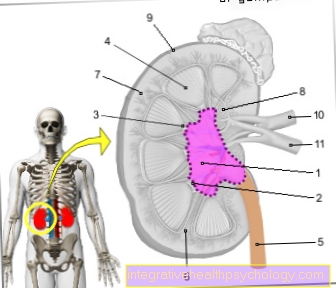Lung function diagnostics in bronchial asthma
General

Bronchial asthma is a chronic inflammatory disease of the airways, which is associated with obstruction, attack-like dyspnoea and spasms of the bronchial muscles.
Bronchial asthma can have different causes, so that one differentiates between allergic and non-allergic asthma. This plays an important role both in diagnosis and in therapy. Most people, however, have mixed forms of both types of asthma, whereby the asthma in children is often triggered by allergies. Adults, on the other hand, suffer more often from the non-allergic form of asthma.
Allergens that can trigger asthma are, for example, pollen or other environmental stimuli. In those affected, there is an excessive immune reaction with the release of various allergy-mediating substances such as histamine, bradykinin and leukotrienes. The development of the non-allergic form of asthma is influenced by various factors. These include drug side effects (see analgesic asthma), infectious diseases of the respiratory tract, reflux diseases and physical exertion. Toxic or irritating substances such as Cleaning agents or room sprays have an influence on this. Finally, tobacco consumption also has a negative impact on lung health and the development of asthma diseases.
In asthmatics, three important factors come together that explain the occurrence of such asthmatic attacks. On the one hand, there is an increased number of inflammatory reactions of the bronchi, which are sometimes accompanied by strong immune reactions. In addition, the bronchial system in asthmatics shows hyperreactivity, which can also be provoked by various substances in medical tests. Ultimately, the bronchi lack adequate cleansing. The result of this lack of self-cleaning of the lungs is that secretions cannot flow away and a vicious circle is formed in that the bronchi are increasingly poorly ventilated and more and more obstructed.
There are now various tests for assessing lung function that are used in asthma. The following text deals in detail with the sequence of the various lung function tests, the parameters to be recorded and the evaluation.
Also read our page Diagnosis of asthma.
Pulmonary function test in asthma
The clinical symptoms are in the diagnosis of the Asthma mostly already decisive. Pulmonary function tests serve here the precise assessment of the current lung function as well as the process control across therapy. Typically, various tests are carried out that are used to ascertain various pulmonary (with respect to the lungs) parameters. These include:
- Spirometry
- Whole body plethysmography
- Pulse oximetry
- Peak flow meter.
The common procedures and their importance in the asthma-Diagnostics are briefly presented below:
1. Spirometry
This procedure forms the basis of asthma diagnostics. Spirometry is a procedure in which the Breathe in and out of the patient through a mouthpiece into the spirometer. Nasal breathing is interrupted by a nose clip. With the help of spirometry different pulmonary parameters or volumes are determined become. For diagnosis obstructive diseases (Diseases in which the airways are narrowed, e.g. asthma) are the One second capacity as well as the Vital capacity important here.
In the Vital capacity it is about the Total amount of maximum inhaled and exhaled air. The One second capacity arises when the After taking a deep breath, the patient exhales the largest possible volume into the spirometer with a forceful breath. In patients with obstructive diseases to whom the bronchial asthma heard is that Exhalation difficult. Therefore, the one-second capacity is then reduced in this test. This test, in which the patient exhales forcibly within one second after maximum inhalation (hence also “forced expiratory volume in one second = FEV1) is called Tiffeneau test. In order to be able to compare the values better, these are set Second capacity in relation to vital capacity, which can also be determined in spirometry. If the seconds capacity is below 80% of the vital capacity, this speaks for an obstructive disorder such as bronchial asthma. In practice, usually three measurements are made, of which the highest value is then taken for evaluation.
The spirometry can be expanded with an ergometer (Ergospirometry). With the help of ergospirometry, the pulmonary volumes under stress measure up. Patients with pronounced bronchial asthma are usually less resilient than people without obstructive disease.
2. Whole body plethysmography
This procedure, which is also called body plethysmography, is essential in the diagnosis of asthma. It serves the definitive confirmation of an obstruction and the differentiation of asthma from other obstructive diseases.
The patient sits in one airtight cabin and breathe in and out normally. At the Inhaling and exhaling changes the pressure in the cabin. These pressure changes are recorded by measuring devices. With full body plethysmography, the Airway resistance as well as the total intrathoracic gas volume, the volume of gas in the entire chest, are recorded. With lung patients with asthma bronchiale shows increased breathing resistance during exhalation. That clearly speaks for one obstruction, because with this the Exhalation difficult is.
3. The peak flow meter
The Peak flow meter serves as a follow-up in asthma diagnostics. It is not suitable for identifying an asthma illness. It is a medical measuring device that measures the measures the maximum flow velocity with forced exhalation.
The examination process is very simple. The patient takes one breath as deeply as he can and holds it briefly. Then he takes the mouthpiece of the peak flow meter in his mouth and tightly encloses it with the Lips. Now he has to exhale as much as possible into the device with a strong breath. A small resistance is built into the tube of the peak flow meter, which is of course shifted more the stronger the patient's exhalation. A pointer then shows a deflection. This rash is higher in people with healthy lungs than in patients with bronchial asthma.
The peak flow meter is not suitable for making an asthma diagnosis because it is a wide range of acceptable values gives. However, it is suitable for monitoring the progress for the following reason: The test can be performed at certain time intervals during asthma therapy repeated This enables the values to be compared with one another or to compare the values with the patient's best value. This shows, for example, whether the patient's condition has improved or worsened somewhat through therapy. Look at this process control the therapy can then be adjusted. Since peak flow meters are not calibrated measuring devices, the same measuring device should always be used to check the progress.
4. Pulse oximetry
The last method of lung function diagnostics used in asthma diagnostics is pulse oximetry. This procedure measures up non-invasive Way the Oxygen saturation of the arterial blood. For this purpose, an adhesive sensor is preferably attached to the finger or the earlobe. In this process, one makes use of that Hemoglobin of the blood absorbs light differently depending on the oxygen level. The device can measure this and thus determine the oxygen saturation, which should normally be above 97%.
In asthmatics, this oxygen saturation may be reduced, because breathing and especially the exhalation of carbon dioxide are difficult.
General information on the procedure for a lung function test can be found at Pulmonary function test.
Summary

In the diagnosis of asthma, various tests to assess lung function are carried out in addition to other examinations. This includes the Spirometry, whole-body plethysmography, the peak flow meter and pulse oximetry.
The Spirometry gives first indications of an existing one obstructionwhich then carried out by the obligatory Body plethysmography beeing confirmed. The Peak flow meter then serves the process control of asthma and can be very helpful in finding the optimal therapy. The Pulse oximetry gives information about the Oxygen saturation of the arterial blood, which can be reduced in lung diseases such as asthma.





























